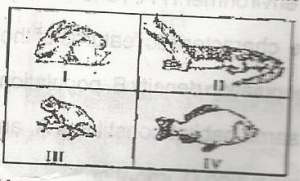(a)(i) State the agricultural classification of specimens M and N.
(ii) What advantage does the cultivation of specimen M have over the cultivation of specimen N?
(b) State (i) the main classes of food in each of Specimens M and N. (i) the functions of the food classes named in 4(b)(i) above.
(c)(i) Describe the state of specimens M and N.
(ii) Name the pest responsible for the state of specimens M and N.
(iii) State the phylum and class of the pest with reasons.
(iv) Name two other crops which tne pest infests.
(d)i) State three adaptive features of the pest to its mode of life.
(ii) State four ways of preventing the activity of the named pest.
(e) State two other pests that can infest specimens M and N
Study specimens C, D, E, F,G and H carefully and use them to answer questions 2a to 2c
(a) Name the fruit types of specimens C,D,E,F.G, and H.
(ii) identify the type or placentation found in 2. C, D, E, F, G and H.
(iii) Describe briefly how specimen D is dispersed.
(c) in a tabular form state four structural differences between specimens G and H.
(a)(I)Name the organisms to which specimens A and B belong.
(ii)) State the habitats of the organisms named n 1(a)) above.
(b) State how the structure of specimens A and B adapt tne organisms to their mode of life.
(c)(i) Outline one difference. (ii) two similarities between specimens A ana B.
(d) Make drawing 8- 10 cm long of specimen B and label fully.

In the diagram, which of the animals represents the oldest creatures in terms of evolutionary history?
- A. iii
- B. ii
- C. i
- D. iv

Use the diagram above to answer this question.With respect to their decreasing dependence on aquatic conditions for reproduction, which of the following is the correct arrangement of the animals represented?
- A. l,IV,II and lll
- B. IV, lll, ll and l
- C. l, ll, IV and lll
- D. lll, ll, IV and l

Use the diagram above to answer this question based on the shape and structure of the beak and feet, the bird represented is likely to feed mainly on?
- A. flesh
- B. fruits
- C. seeds
- D. nectar

Use the diagram above to answer this question.The main function of the feathers covering the part labeled I is to?
- A. prevent ectoparasites from attacking the animal
- B. generate heat to keep the animal warm
- C. provide some power for flight
- D. serve as insulator to maintain body heat

Use the diagram above to answer this question.During photosynthesis, the arrow labeled ll represents the?
- A. escape of mineral salts
- B. absorption of energy from the sun
- C. release of carbon (IV) oxide
- D. release of oxygen as a by-product

Use the diagram above to answer this question.The movement of material in the xylem and phloem tissues of the plant are represented by the arrows labeled?
- A. lV and III respectively
- B. ll and l respectively
- C. l and ll respectively
- D. l and lll respectively

Use the diagram above to answer this question.Which of the following is a true feature of plantation ll?
- A. it has the highest number of trees of about 2m high.
- B. it has highest number of trees
- C. it has the highest number of tall trees
- D. the height of all its trees range between 2m and 6m

Use the diagram above to answer this question.In which plantation are all the trees between the height of 2-4m?
- A. lll
- B. ll
- C. l
- D. lV
If both parents are heterozygous for a trait, the probability that an offspring will be recessive for that trait is?
- A. \(\frac{1}{2}\)
- B. \(\frac{3}{4}\)
- C. \(\frac{1}{4}\)
- D. 1
The flippers of a whale and the fins of a fish are examples of?
- A. divergent evolution
- B. coevolution
- C. continous variation
- D. convergent evolution
The main distinguishing features between the soldier termite and other members of the caste are the?
- A. presence of wings, possession of a small head and large thorax
- B. presence of wings, possession of a large thorax and a small head
- C. absence of wings, possession of strong mandibles and a large head
- D. absence of wings,possession of big head and the absence of mandible
At what stage in the life history of a mammal is the sex of an individual set?
- A. at adolescence
- B. at puberty
- C. at birth
- D. at conception
The chromosome number of a cell before and after the process of meiosis is conventionally represented as?
- A. 2n → 2n
- B. n → n
- C. n → 2n
- D. 2n → n
A pair of genes that control a trait is referred to as?
- A. an allele
- B. recessive
- C. dominant
- D. a hybrid
Thyroxine and adrenalin are examples of hormones which control?
- A. blood grouping
- B. tongue rolling
- C. behavioural patterns
- D. colour variation
A dilute solution of phenylthiocarbamide tastes bitter to some people and is tasteless to others. This is an example of?
- A. taste bud variation
- B. discontinuous variation
- C. morphological variation
- D. continuous variation
The protozoan plasmodium falciparum is transmitted by?
- A. female Anopheles mosquitoes
- B. female Aedes mosquitoes
- C. female Culex mosquitoes
- D. Female blackfly
The loss of soil through erosion can be reduced by?
- A. watering
- B. crop rotation
- C. manuring
- D. irrigation


